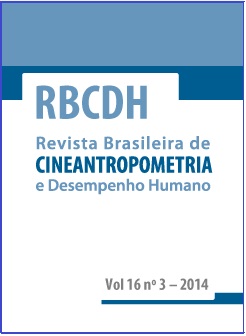Morphological, maturational, functional and technical profile of young Brazilian soccer players
DOI:
https://doi.org/10.1590/1980-0037.2014v16n3p277Abstract
The objectives of this study were to describe and compare the anthropometric profile, physical fitness and soccer-specific skills between under-15 and under-17 Brazilian soccer players, as well as to evaluate possible differences in these variables according to biological maturation in the age categories. The sample consisted of 245 male soccer players (under-15: n=161; under-17: n=84). Anthropometric measures included weight, height and skinfolds. Biological maturation was assessed based on pubic hair development. The following tests were used for functional assessment: static and countermovement jump, Yo-Yo intermittent endurance test (level 2), RAST, 5- and 30-meter running speed, and agility T-test. Soccer-specific skills were assessed using three tests: ball control, dribbling, and kick accuracy. Descriptive statistics, t-test and analysis of variance (ANOVA) were used for statistical analysis. The results showed a larger body size (stature and body mass), longer sports experience (years of formal training) and better performance in most of the functional tests for under-17 soccer players compared to under-15 players. There were no significant differences in adiposity or soccer-specific skills between levels of competition. Significant differences as a function of maturation stage were observed in anthropometric and functional variables only in the under-15 category. In conclusion, the under-17 category differs from the under-15 category in terms of anthropometric and physical fitness characteristics. However, no difference was observed in two of the three soccer-specific skills. Physical fitness components and soccer-specific skills were associated with maturity only in the under-15 category.



